Piazza Scossacavalli
 Partial view of piazza Scossacavalli with the Borgo Vecchio road, the palazzo dei Convertendi and St. Peter's Basilica in the background (c.1930) | |
 Click on the map for a fullscreen view | |
| Former name(s) | Piazza di San Clemente Piazza di Trento Piazza d'Aragona Piazza Salviati |
|---|---|
| Location | Rome, Italy |
| Quarter | Borgo |
| Coordinates | 41°54′08.4″N 12°27′39.9″E / 41.902333°N 12.461083°E |
| Construction | |
| Demolished | 1936–1937 |
Piazza Scossacavalli, also named Piazza di San Clemente, Piazza di Trento, Piazza d'Aragona, Piazza Salviati,[1] was a square in Rome, Italy, important for historical and architectonic reasons. The square was demolished together with the surrounding quarter in 1937 due to the construction of Via della Conciliazione.
Location
Located in the
Naming

The square's name derives from that of the church of
The square bore also several other names, all linked to
History
Roman age and Middle Ages

In the
The northern side of the church was bordered by a blind lane ending by a vegetable garden and the
Renaissance

The golden age of the piazza started with the
In 1499,
Along the western side of piazza Scossacavalli, at the corner with Borgo Vecchio, in the 15th century lay a house property of Bartolomeo Zon [27] which hosted two deposed queens: Catherine of Bosnia, which lived there in 1477–78,[28] and Charlotte of Cyprus.[29] Some years later, on the other end of the piazza's west side, at the corner with Borgo Nuovo, the Caprini family from Viterbo let erect by Bramante their Roman residence.[24] The palace was then bought by Raphael, who completed it and spent there the last 3 years of his life, dying there in 1520.[27] After 1584, after changing several owners, the palace was acquired by Camilla Peretti, the sister of Pope Sixtus V (r. 1585–90), who bought it on behalf of her brother for her grandnephew, Cardinal Alessandro Peretti di Montalto.[30] Camilla Peretti bought also some houses facing Piazza Scossacavalli and Borgo Vecchio, so that the palace reached its full extension.[30]
On the east side, shortly after 1520 the
Baroque and modern age

At the beginning of the seventeenth-century, piazza Scossacavalli reached its definitive aspect, with a
Demolition
In the 1930s, with the decision to open a large road between Castel Sant'Angelo and Saint Peter, the fate of the piazza was sealed:
the spina di Borgo with piazza Scossacavalli was demolished between 29 October 1936 and 8 October 1937.
The memory of the square survives in a short street ("via Scossacavalli") which links Borgo Santo Spirito and Via della Conciliazione.[6]
References
- ^ a b c d e Gigli 1992, p. 7.
- ^ Delli 1988, p. 194.
- ^ Delli 1988, p. 199.
- ^ Baronio 1697, p. 65.
- ^ a b c Gigli 1992, p. 8.
- ^ a b c Delli 1988, p. 857.
- ^ Cambedda 1990, p. 50.
- ^ a b Gigli 1992, p. 26.
- ^ a b Gigli 1992, p. 24.
- ^ De Caro 1961.
- ^ Ceccarelli 1938, p. 20.
- ^ Gigli 1990, p. 9.
- ^ Gigli 1992, p. 9.
- ^ Borgatti 1926, p. 4.
- ^ Borgatti 1926, p. 62.
- ^ Gigli 1990, p. 8.
- ^ a b c d Borgatti 1926, p. 161.
- ^ a b Gigli 1990, p. 25.
- ^ Aurigemma 2016, p. 125.
- ^ Gigli 1992, p. 22.
- ^ Cambedda 1990, p. 48.
- ^ a b Cambedda 1990, p. 47.
- ^ Cambedda 1990, p. 62.
- ^ a b Gigli 1992, p. 44.
- ^ a b Gigli 1992, p. 72.
- ^ Gigli 1992, p. 64.
- ^ a b Gigli 1992, p. 46.
- ^ Borgatti 1926, p. 162.
- ^ Borgatti 1926, p. 163.
- ^ a b c Gigli 1992, p. 50.
- ^ a b Gigli 1992, p. 10.
- ^ Cambedda 1990, p. 57.
- ^ Gigli 1992, p. 70.
- ^ Borgatti 1926, p. 211.
- ^ Gigli 1990, p. 33.
- ^ Gigli 1992, p. 12.
- ^ Gigli 1992, p. 28.
- ^ Gigli 1992, p. 56.
- ^ a b Gigli 1992, p. 60.
- ^ Renzi 2016, p. 171.
Sources
- Baronio, Cesare (1697). Descrizione di Roma moderna (in Italian). Roma: M.A. and P.A. De Rossi.
- Borgatti, Mariano (1926). Borgo e S. Pietro nel 1300 – 1600 – 1925 (in Italian). Roma: Federico Pustet.
- Ceccarelli, Giuseppe (Ceccarius) (1938). La "Spina" dei Borghi (in Italian). Roma: Danesi.
- Castagnoli, Ferdinando; Cecchelli, Carlo; Giovannoni, Gustavo; Zocca, Mario (1958). Topografia e urbanistica di Roma (in Italian). Bologna: Cappelli.
- De Caro, Gaspare (1961). "Luigi d'Aragona". Dizionario Biografico degli Italiani (in Italian). Vol. 3.
- Delli, Sergio (1988). Le Strade di Roma (in Italian). Roma: Newton & Compton.
- Gigli, Laura (1990). Guide rionali di Roma (in Italian). Vol. Borgo (I). Fratelli Palombi Editori, Roma. ISSN 0393-2710.
- Gigli, Laura (1992). Guide rionali di Roma (in Italian). Vol. Borgo (II). Fratelli Palombi Editori, Roma. ISSN 0393-2710.
- Cambedda, Anna (1990). La demolizione della Spina dei Borghi (in Italian). Fratelli Palombi Editori, Roma.
- Benevolo, Leonardo (2004). San Pietro e la città di Roma (in Italian). Laterza, Bari. ISBN 8842072362.
- Aurigemma, Maria Giulia (2016). Claudio Parisi Presicce; Laura Petacco (eds.). Palazzo di Domenico della Rovere (in Italian). Rome. )
- Renzi, Tania (2016). Claudio Parisi Presicce; Laura Petacco (eds.). Una fontana senza pace: la fontana di piazza Scossacavalli (in Italian). Rome. )
